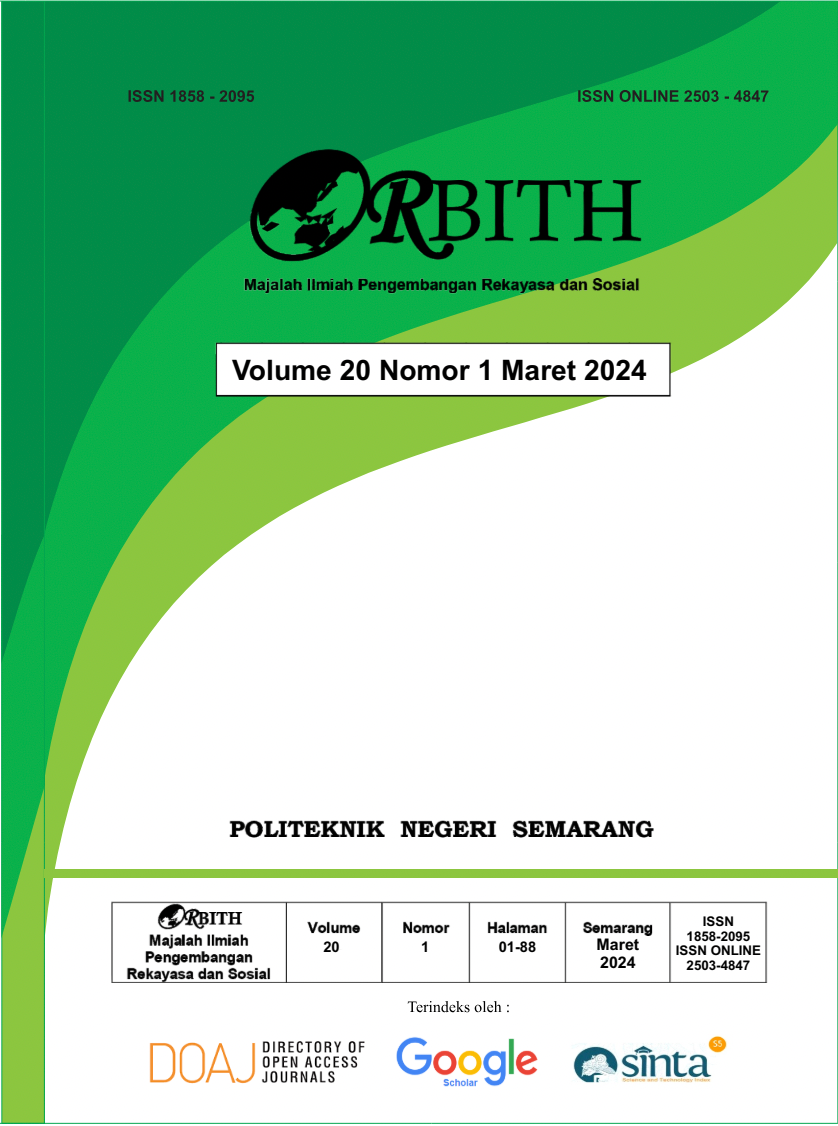RANCANG BANGUN SIMULATOR PEMBANGKIT LISTRIK TENAGA PIKOHIDRO MENGGUNAKAN VARIABLE SPEED DRIVE SEBAGAI PENGATUR KECEPATAN PUTARAN
DOI:
https://doi.org/10.32497/orbith.v20i1.5630Keywords:
PLC, picohydro power plant, turbine, SCADA, variable speed driveAbstract
Abstrak
Pembangkit listrik tenaga pikohidro (PLTPH) potensial digunakan sebagai pembangkit listrik terbarukan yang dapat dimanfaatkan oleh pengguna listrik skala rumah tangga maupun UMKM. PLTPH memiliki keterbatasan dikarenakan debit aliran air pada sungai yang fluktuatif. Tujuan penelitian ini adalah merancang simulator PLTPH dan menganalisis potensi daya yang dapat dibangkitkan. Penelitian ini menggunakan pompa booster untuk menambah debit aliran sebagai penggerak turbin. Motor listrik tiga fasa digunakan untuk menambah putaran turbin pada simulator PLTPH. Sumber energi listrik dari PLN digunakan untuk mensuplai daya pompa booster dan motor listrik tiga fasa pada simulator. Penelitian ini mengusulkan penggunaan variable speed drive (VSD) untuk menggendalikan kecepatan putaran pompa booster dan motor listrik. Pengujian simulator PLTPH menunjukkan bahwa frekuensi VSD berbanding lurus dengan kecepatan putaran motor, turbin, dan generator. Kecepatan putaran maksimal generator sebesar 3432 rpm. Potensi debit aliran yang dihasilkan adalah 64,8 lpm dan potensi daya yang dapat dibangkitkan sebesar 15,08 W.
Abstract
Picohydro power plants (PLTPH) have the potential to be used as renewable energy that can be utilized by household customers and UMKM. PLTPH has problems due to fluctuating river or channel water flows. The aim of this research is to design a PLTPH simulator and analyze the potential power that can be generated. This research uses a booster pump to increase the flow rate to drive the turbine. A three-phase electric motor is used to increase the turbine rotation in the PLTPH simulator. Electrical energy sources from PLN are used to supply power to the booster pump and three-phase electric motor in the simulator. This research proposes the use of a variable speed drive (VSD) to control the rotation speed of booster pumps and electric motors. PLTPH simulator testing shows that the VSD frequency is directly proportional to the rotation speed of the motor, turbine and generator. The maximum rotation speed of the generator is 3432 rpm. The potential flow rate produced is 64,8 lpm and the potential power that can be generated is 15,08 W
References
Aripriharta, A. (2023). Perancangan Kendali Motor Induksi Menggunakan Variable Speed Drive. Journal Kajian Teknik Elektro, 8(1), 1”“6.
Badrus Soleh, A., Supriyanto, A., Ahmad Pauzi, G., & Arif Surtono, dan. (2020). Analisis Potensi Energi Listrik Pikohidro dari Sumber Air Pegunungan Serta Upaya Peningkatan Daya Listrik dengan Memanfaatkan Rangkaian Joule Thief. Journal of Energy, Material, and Instrumentation Technology, 1(3), 91”“102. https://doi.org/10.23960/JEMIT.V1I3.32
Bandri, S., Premadi, A., & Andari, R. (2021). Studi Perencanaan Pembangkit Listrik Tenaga Picohydro (PLTPh) Rumah Tangga. Jurnal Sains Dan Teknologi, 21(1).
Bird, J. O., & Chivers, P. J. (1993). Newnes engineering and physical science pocket book. Newnes. http://www.sciencedirect.com:5070/book/9780750616836/newnes-engineering-and-physical-science-pocket-book
Eismin, T. K. (2019). Aircraft Electricity and Electronics. McGraw-Hill Education. https://www.accessengineeringlibrary.com/content/book/9781260108217
Halimatussadiah, A., Amanda Siregar, A., & Farah Maulia, R. (2020). Unlocking Renewable Energy Potential in Indonesia: Assessment on Project Viability. https://databoks.katadata.co.id/datapublish/2020/01/10/
Ismail, & Supriono. (2013). Analisis Ekonomi Energi Perencanaan Pembangkit Listrik Tenaga Mikrohidro Meragun (Desa Meragun, Kec. Nanga Taman, Kab. Sekadau). Jurnal ELKHA, 5(1).
Langer, J., Quist, J., Blok, K., Ulgiati, S., Schnitzer, H., & Santagata, R. (2021). Review of Renewable Energy Potentials in Indonesia and Their Contribution to a 100% Renewable Electricity System. Energies 2021, Vol. 14, Page 7033, 14(21), 7033. https://doi.org/10.3390/EN14217033
Lenzen, M. (2010). Current State of Development of Electricity-Generating Technologies: A Literature Review. Energies 2010, Vol. 3, Pages 462-591, 3(3), 462”“591. https://doi.org/10.3390/EN3030462
Marwani, M., Kadir, M. Z., & Putra, R. E. (2021a). Investigation Performance of Pico Hydro Water Pipe Turbine. Indonesian Journal of Engineering and Science, 2(3), 051”“058. https://doi.org/10.51630/ijes.v2i3.27
Molla, S., Farrok, O., & Alam, M. J. (2024). Electrical energy and the environment: Prospects and upcoming challenges of the World”™s top leading countries. Renewable and Sustainable Energy Reviews, 191, 114177. https://doi.org/10.1016/J.RSER.2023.114177
Mufidah, Albetris, & Johar, L. W. (2021). Efisiensi Pakan dengan Pembangkit Listrik Pico Hydro dan Digitalisasi Pemasaran di Desa Lopak Alai. ABDIMAS EKODIKSOSIORA: Jurnal Pengabdian Kepada Masyarakat Ekonomi, Pendidikan, Dan Sosial Humaniora (e-ISSN: 2809-3917), 1(1), 74”“80. https://doi.org/10.37859/ABDIMASEKODIKSOSIORA.V1I1.3352
Paundra, F., & Nurdin, A. (2022). STUDY OF THE POTENTIAL AND DEVELOPMENT OF RENEWABLE ENERGY POWER IN INDONESIA : A REVIEW. In Technology, Education And Mechanical Engineering (Vol. 10, Issue 2).
Purwanto, S. A., Suyono, H., & Hasanah, R. N. (2013). Strategi Interkoneksi Suplai Daya 2 Pembangkit di PT Ajinomoto Indonesia, Mojokerto Factory. Jurnal Mahasiswa TEUB, 1(1). http://elektro.studentjournal.ub.ac.id/index.php/teub/article/view/28
Rahman, A., Farrok, O., & Haque, M. M. (2022). Environmental impact of renewable energy source based electrical power plants: Solar, wind, hydroelectric, biomass, geothermal, tidal, ocean, and osmotic. Renewable and Sustainable Energy Reviews, 161, 112279. https://doi.org/10.1016/J.RSER.2022.112279
Ramadhan, B. N., Pratama, D. A., & Rasyad, S. (2022). Analysis Control Speed Of Frequency Changes In Three Phase Induction Motor Based On VSD. Indonesian Journal of Electrical Engineering and Renewable Energy (IJEERE), 2(2), 70”“77. https://doi.org/10.57152/IJEERE.V2I2.395
Ramos, H. (1999). Guidelines for Design of Small Hydropower Plants. Western Reg. Energy Agency & Network. https://books.google.co.id/books/about/Guidelines_for_Design_of_Small_Hydropowe.html?id=kBRt0AEACAAJ&redir_esc=y
Setyono, A. E., & Kiono, B. F. T. (2021). Dari Energi Fosil Menuju Energi Terbarukan: Potret Kondisi Minyak dan Gas Bumi Indonesia Tahun 2020 ”“ 2050. Jurnal Energi Baru Dan Terbarukan, 2(3), 154”“162. https://doi.org/10.14710/jebt.2021.11157
Shamoon, A., Haleem, A., Bahl, S., Javaid, M., Bala Garg, S., Chandmal Sharma, R., & Garg, J. (2022). Environmental impact of energy production and extraction of materials - a review. Materials Today: Proceedings, 57, 936”“941. https://doi.org/10.1016/J.MATPR.2022.03.159
Shultz, G. P. (2012). Transformers and motors: A single-source reference for electricians. Transformers and Motors: A Single-Source Reference for Electricians, 1”“320. https://doi.org/10.1016/B978-0-08-051958-6.50001-9
Solemslie, B. W., & Dahlhaug, O. G. (2014). A reference pelton turbine - Design and efficiency measurements. IOP Conference Series: Earth and Environmental Science, 22. https://doi.org/10.1088/1755-1315/22/1/012004
Tanjung, A. (2018). ANALISIS PENGGUNAAN ENERGI LISTRIK MOTOR INDUKSI TIGA PHASA MENGGUNAKAN VARIABLE SPEED DRIVE (VSD). Jurnal Sain, Energi, Teknologi & Industri), 2(2), 52”“59.
Taufiqurrahman, A., & Windarta, J. (2020). Overview Potensi dan Perkembangan Pemanfaatan Energi Air di Indonesia. Jurnal Energi Baru Dan Terbarukan, 1(3), 124”“132. https://doi.org/10.14710/jebt.2020.10036
TkáÄ, Å . (2018). Hydro power plants, an overview of the current types and technology. Selected Scientific Papers - Journal of Civil Engineering, 13(s1), 115”“126. https://doi.org/10.1515/SSPJCE-2018-0011
Singh, V. P. (2017). Handbook of Applied Hydrology, Second Edition. In Chow”™s Handbook of Applied Hydrology (Issue November). McGraw-Hill Education. https://www.accessengineeringlibrary.com/content/book/9780071835091
Zakir, L. M. H., Windarta, J., Saptadi, S., & Rinaldo, D. (2019). Analysis of planning for utilization of East Borneo hydro power with techno economy principle. AIP Conference Proceedings, 2202(1). https://doi.org/10.1063/1.5141729/962446
Downloads
Published
Issue
Section
License
Authors who publish with this journal agree to the following terms:Authors retain copyright and grant the journal right of first publication with the work simultaneously licensed under a Creative Commons Attribution License that allows others to share the work with an acknowledgement of the work's authorship and initial publication in this journal.
Authors are able to enter into separate, additional contractual arrangements for the non-exclusive distribution of the journal's published version of the work (e.g., post it to an institutional repository or publish it in a book), with an acknowledgement of its initial publication in this journal.
Authors are permitted and encouraged to post their work online (e.g., in institutional repositories or on their website) prior to and during the submission process, as it can lead to productive exchanges, as well as earlier and greater citation of published work (See The Effect of Open Access).






